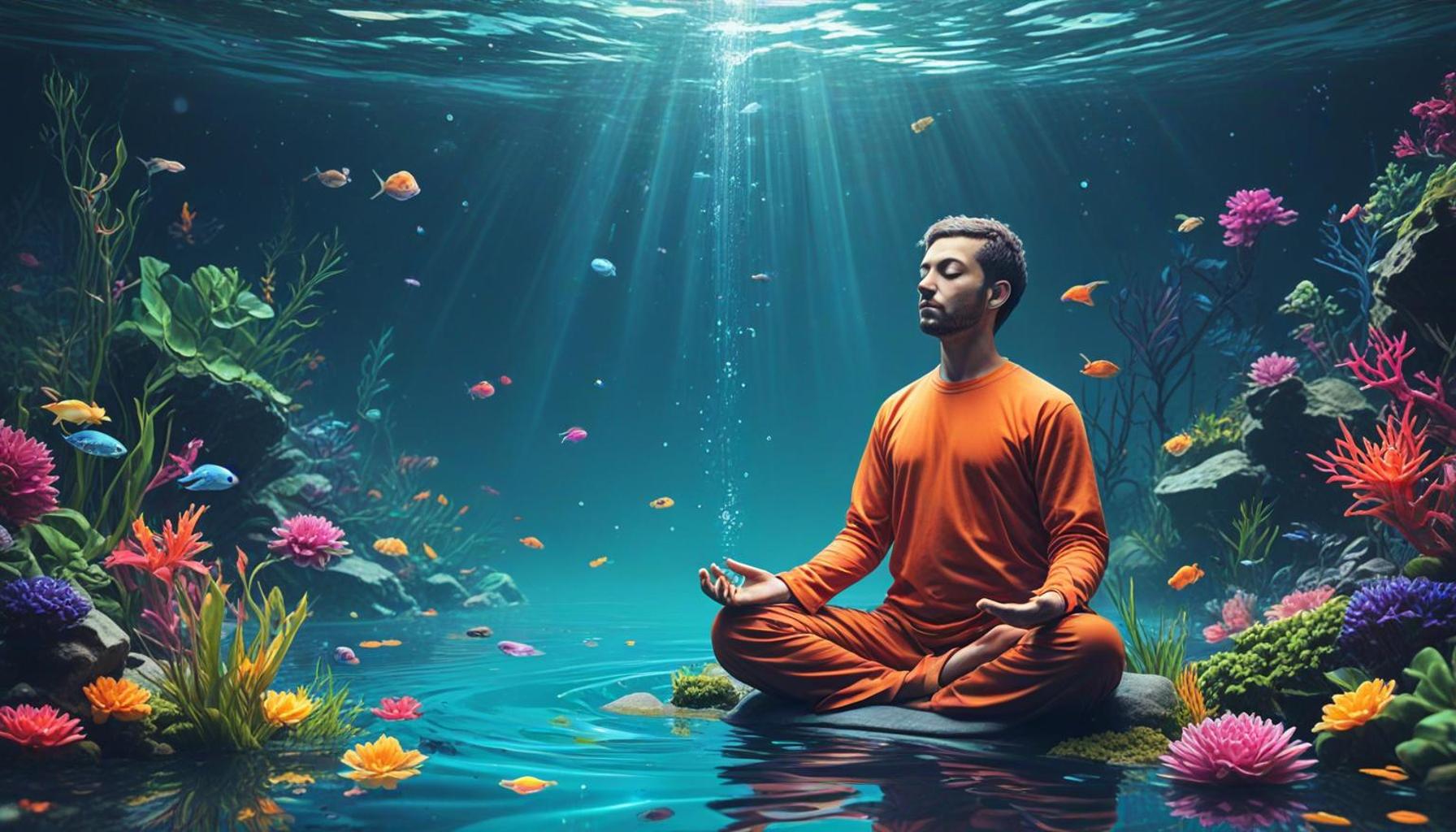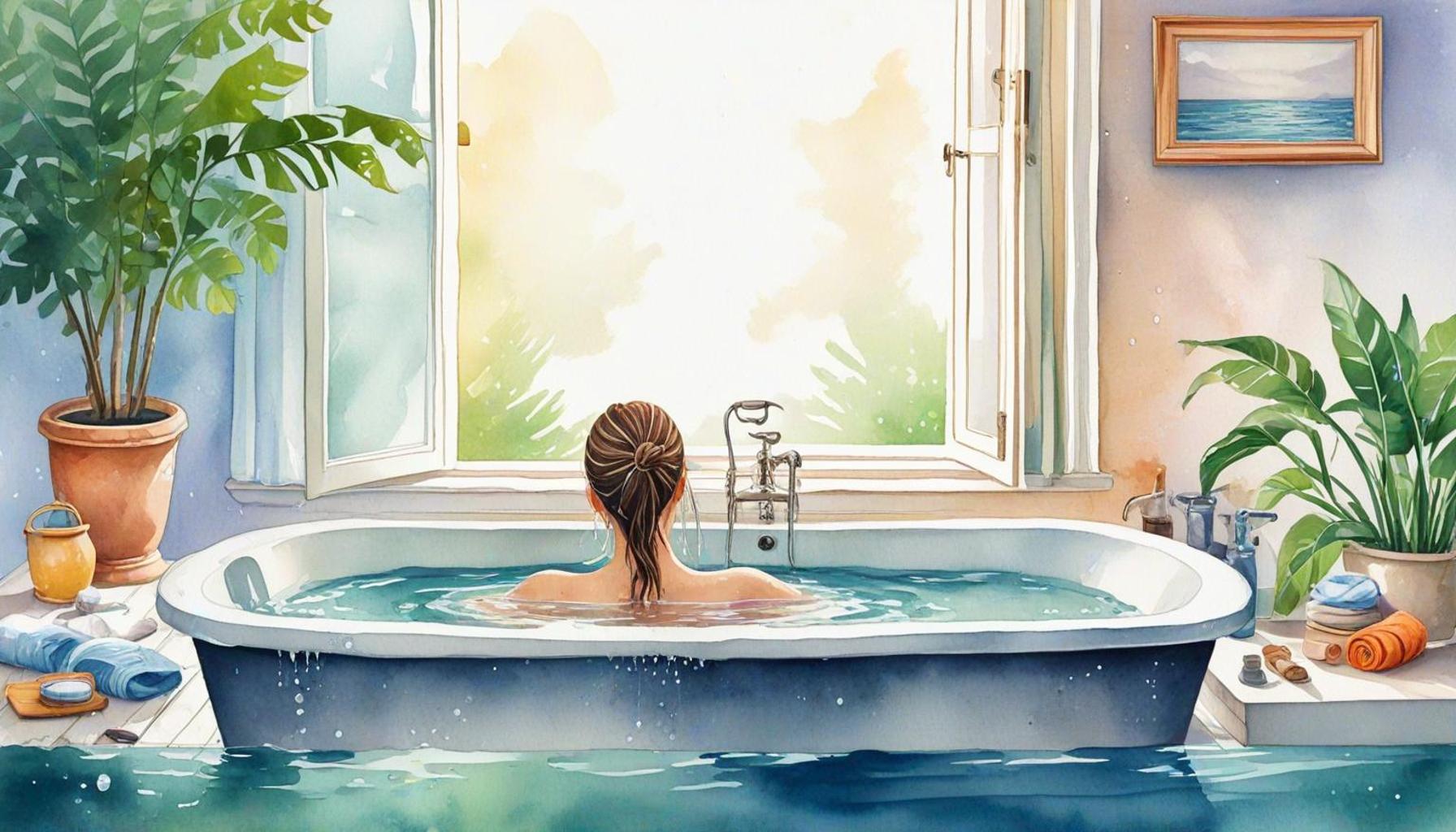Meditating Under Water: Visualization Techniques for Stress Relief

Embracing the Art of Underwater Meditation
Amidst the hustle and bustle of daily life, the quest for effective stress reduction becomes increasingly important. One unique technique gaining traction is meditating under water. This innovative approach marries the calming effects of water with guided visualization, providing a deeply immersive experience that promises not just relaxation, but a profound connection with one’s inner self.
Imagine the gentle embrace of water surrounding you, as you float weightlessly beneath the surface. The distractions of the outside world dissolve away, allowing you to delve into a sanctuary of tranquility. In this serene environment, various visualization techniques can be employed to amplify your meditation practice:
- Visualizing a peaceful underwater landscape: Picture yourself exploring a vibrant coral reef teeming with life or gliding through a quiet underwater cave illuminated by shafts of light. These vivid scenes can transport your mind, invoking a profound sense of peace.
- Breathing techniques: Synchronizing your breath with the natural rhythm of the water can enhance relaxation. As you inhale deeply and exhale slowly, the ebb and flow of the water mimics your breath, creating a calming cycle.
- Mindfulness practices: Embrace the soothing sounds of bubbles and gentle currents. Focusing on these natural melodies can anchor your thoughts, leading to a deep meditative state where stress melts away.
Water has long been celebrated for its therapeutic properties. In Nigeria, with its wealth of accessible natural water bodies—be it the serene lagoons of Lagos or the tranquil rivers of Benue—underwater meditation becomes a feasible practice for many seeking relaxation. The soothing qualities of water can help lower cortisol levels, the body’s primary stress hormone, while also promoting a sense of calm and well-being.
As you venture into this underwater realm of meditation, you may discover benefits that extend beyond mere relaxation. Participants often report enhanced clarity of mind, improved emotional regulation, and a renewed sense of connection to themselves and their environment. The practice invites you to slow down, listen, and truly feel, creating pathways for self-discovery.
Join us in exploring the transformative effects of meditation beneath the waves, where the fusion of water and mindfulness may very well lead to a profound shift in your approach to stress relief and personal wellness.
SEE ALSO: Click here to read another article
Unlocking Stress Relief Through Visualization
Underwater meditation offers a transformative experience that not only invites relaxation but also promotes holistic well-being. This unique practice encourages individuals to engage their imagination through visualization techniques, effectively crafting a personal oasis of tranquility beneath the surface of the water. Drawing upon the natural beauty and fluidity of aquatic environments, this method can profoundly impact emotional and psychological states.
In the vibrant waters of Nigeria, where both coastal and freshwater ecosystems exist, the opportunity for underwater meditation is vast. Whether you find yourself submerged in the tranquil embrace of the Inland waterways of Benue or the captivating surf along the Lagos coastline, each experience can be enriched through targeted visualizations. Let’s explore some key techniques that can be implemented while meditating under water:
- Imagining a moral compass: Picture a glowing light or an ethereal guiding entity that assists you in navigating the waters of your mind. This visualization can symbolize clarity, guiding your thoughts towards stress relief and emotional balance.
- Visualizing vibrant life: Envision schools of colorful fish dancing around you or the harmonious rhythm of aquatic plants swaying in the current. Connecting this imagery with your breathing can deepen your experience, allowing for a greater appreciation of nature’s beauty and its calming influence.
- Creating a sanctuary: Visualize an underwater haven designed only by your desires—perhaps a serene garden filled with essential elements that bring you peace. This mental space serves as a haven, allowing you to retreat to a place of comfort and healing.
Through the act of visualization, practitioners can channel positive energy and redirect attention from anxiety-inducing stimuli to serene thoughts. Engaging with the ambiance of water can enhance these techniques, as the gentle sound of water and the buoyancy experienced while beneath the surface can evoke a distinct sense of comfort. As part of the wider exploration of meditation and stress relief, it becomes apparent that underwater environments may amplify the effectiveness of these practices.
Moreover, various studies have revealed that immersing oneself in water can lead to lower blood pressure, improved mood, and heightened levels of comfort. For many, the act of being submerged can reduce feelings of isolation and foster a stronger sense of belonging—key components in combating the stress of everyday life in an evolving urban landscape.
So, as you embark on this journey of self-discovery through underwater meditation, consider how visualization can reshape your understanding of stress relief. By implementing these enriching techniques, you can unlock new pathways for relaxation, emotional regulation, and personal empowerment within your practice.
Meditating Under Water: Visualizing Calm and Clarity
Meditation techniques have evolved significantly over the years, and one of the most intriguing forms combines the tranquil environment of water with visualization strategies. Meditating under water enhances the practice by utilizing both the physical and psychological benefits of this unique setting. As you submerge yourself, the surrounding silence and buoyancy create a peaceful environment that allows for deep relaxation. In this serene atmosphere, your ability to visualize becomes enhanced, turning your practice into a profound journey of self-discovery and stress relief.
As the water envelops your body, it dramatically reduces external distractions, allowing you to focus on your inner thoughts and feelings. The gentle pressure of water on your skin can have a calming effect, which aids in reducing anxiety levels and allows for a deeper state of meditation. With each breath, you become more attuned to your body, fostering a connection that often eludes us in our busy lives.
Employing visualization techniques while underwater can also amplify your sense of peace. Imagine visuals of serene ocean landscapes, vibrant coral reefs, or even drifting clouds above you as you float. These mental images not only distract from stressors but can also be used to manifest a sense of well-being, where positive outcomes are vividly imagined and felt. This practice of visualization in a calming environment can induce a state of mindfulness, encouraging both relaxation and emotional balance.
| Category | Advantages |
|---|---|
| Enhanced Relaxation | Water’s buoyancy alleviates tension, promoting a deeper state of calm. |
| Improved Visualization | The aquatic setting enhances visual imagery for positive outcomes, increasing focus. |
Moreover, the practice of meditating under water can improve your overall mental health. When practiced regularly, these techniques may reduce symptoms of stress and anxiety while providing a unique approach to mindfulness. Engaging with visualization techniques and the soothing presence of water creates a holistic method to embrace tranquility in a world often filled with chaos.
SEE ALSO: Click here to read another article
Enhancing Your Underwater Meditation Experience
To fully embrace the practice of meditating under water, it is essential to create an environment conducive to relaxation and focus. Beyond visualization techniques, there are additional elements you can incorporate to enhance your experience, leading to more profound stress relief and personal insight.
As you prepare for your underwater session, consider the importance of setting the scene. Choose a location where you feel safe and comfortable. In Nigeria, this might mean finding a placid area of the Atlantic beaches in Lagos or a serene spot along the riverbanks of Cross River State. Take time to observe your surroundings, engaging your senses to appreciate the unique sounds and sights of aquatic life. This mindfulness can establish a deeper connection with your environment, enriching your meditation experience.
In addition, timing plays a significant role in the success of underwater meditation. Early mornings or late afternoons often offer the calmest waters, making it easier to maintain focus. The peacefulness of the world around you can drastically enhance your ability to visualize and immerse yourself in your mental imagery. According to reports, many practitioners find that these tranquil hours coincide with lower wind speeds and reduced disturbances, allowing for a more profound meditative state.
Breath control is another critical element to consider when practicing underwater meditation. Focusing on your breathing not only aids in relaxation but also facilitates the visualization process. As you inhale deeply and exhale slowly, synchronize your breath with your visualizations. For instance, you might imagine inhaling light and exhaling stress, creating a continuous flow of positive energy around you.
Exploring the physical sensations associated with water can also deepen your meditation experience. The feeling of buoyancy may evoke a sense of weightlessness, allowing thoughts and worries to drift away. You may visualize each bubble you release as a negative thought or a tension fading into the depths, leaving your mind clear and serene. Research suggests that engaging with your physical sensations while meditating can enhance emotional release and produce a calming effect.
Furthermore, consider incorporating the element of Sound. The soothing rhythm of water enveloping you can be reinforced by utilizing meditative music or sounds from nature. Sounds of gentle waves or bubbles can create an immersive auditory backdrop, enhancing visualizations of aquatic life around you. This, coupled with the natural echoes of your surroundings, can serve to ground you in your practice and amplify your experience of connection to nature.
Lastly, keep a journal to record your sensations, thoughts, and visualizations following each underwater meditation session. Reflecting on your experiences can help you recognize patterns, allowing you to fine-tune your practice for maximum benefit. Regular journaling not only provides valuable insights into your emotional state but can also highlight the progress you make over time on your journey to better stress management.
With each underwater meditation, the combination of visualization, mindful environment, breath control, and sensory engagement empowers you to navigate the waters of stress and anxiety. The tranquil aquatic world offers a unique refuge where one can explore the depths of the mind while reaping the benefits of nature’s calming embrace.
LEARN MORE: This related article may interest you
Conclusion
In conclusion, meditating under water is more than just an innovative practice; it is a transformative journey that offers profound stress relief through unique visualization techniques. By engaging fully with your surroundings—be it the tranquil Atlantic beaches in Lagos or the serene waters of the Cross River State—you harness the natural beauty and calming influences of your environment. The blend of mindful awareness, breath control, and sensory exploration fosters not only relaxation but also deeper personal insight.
The timing and setting of your underwater meditation play pivotal roles in its effectiveness. Early mornings or late afternoons provide the tranquillity necessary for a focused state of mind, while the gentle sound of water enhances the visualizations that promote emotional clarity. Furthermore, managing your breath can lead to a more profound experience, allowing stress to dissolve as you envision releasing negative thoughts.
As you embark on this underwater meditative journey, consider maintaining a journal to document your experiences. This reflection will not only highlight your progress but also sharpen your understanding of the emotional landscape you navigate. Ultimately, meditating under water extends beyond individual practice; it connects you with nature and empowers you to manage stress effectively in your daily life.
As the world continues to evolve, incorporating practices like these provides accessible tools for mental resilience. Whether you are an experienced meditator or just beginning your journey, allowing the soothing embrace of water to guide you offers a refreshing pathway to tranquility and self-discovery. With every dive, discover the myriad ways the aquatic realm can rejuvenate both the mind and spirit.



